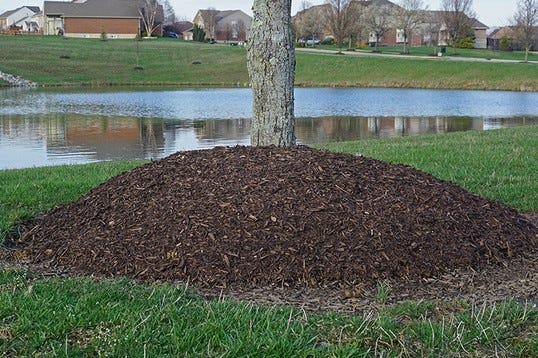
Sports fans recognize March Madness for all the great college basketball games in the NCAA tournament. I recently read a weekly bulletin from Ohio State University Extension where our local agent, Joe Boggs, used the term "Mulch Madness." Joe was referring to the way mulch is misused in landscapes.
The first violation of "Mulch Madness" is putting down mulch too early. At this time of the year, the soil is still holding moisture from the winter's snow and rain. The soil needs to dry out. One of the purposes of mulch is to retain moisture, so you'll want to wait to apply new mulch. If you still have a thick layer of mulch from last year, you should use a cultivating tool to loosen it. This will allow more air into the soil to help it dry out.
Spring is here!Your early spring gardening 'to-do' list 📝
It is best to wait until mid-to-late April before you start to mulch. So, what about all those landscaper trucks we see loaded down with mulch at this time of year? Those companies are doing what is best for cash flow, versus what is good for the customer's landscape. Most of those businesses are centered around grass cutting, and they want to get the mulch down before the grass starts to grow.
What type of mulch should you use? How much should you put down?
When it comes time to put the new mulch down, make sure you are not putting down too much. Mulch should never be any thicker than two or three inches maximum. This would include the combination of existing mulch and new mulch.
Hardwood mulches are the most popular. Some of them do not always break down and decompose quickly. This can be a benefit as well as a detriment. If the existing mulch is not breaking down before new mulch is added, you can easily pass the maximum thickness in the second season. This can cause a conflict if you like the look of fresh mulch, but your old mulch is not breaking down quickly. In this situation, you may need to remove some of the old mulch.
Thinking of a landscape renovation?There's a class for that
If you find yourself in this situation, learn from this lesson. Two to three inches is the maximum, but an inch will work just as well. If you are conservative when you put the first layer of mulch down, it will decompose faster. You should have room each season for a new thin layer.

Here's what not to do during 'Mulch Madness'
The worst violations of "Mulch Madness" are found around trees. Mulch should never be piled up on the trunk of a tree. The worst cases of this are when mulch is piled a foot or more onto the trunk of the tree. We call this a "mulch volcano," and it will slowly kill the tree.
Bud watch!These plants bloom early in Cincinnati 🌼
Frost? Freeze?Here's when to worry about plants 🥶
The base of every tree has what is called a trunk flare. This is where the trunk spreads out on the top of the soil. This should never be covered with mulch. The soil ring around the tree can have the two to three inches of mulch – as long as the trunk flare is exposed.

Benefits of using mulch in landscaping
The mulch you use should be made from organic materials, because they will break down over time, improving the soil beneath. While this is happening, the mulch helps retain moisture in the summer months.
Gardening tips:Combat garden pests with these green alternatives
Another benefit of mulch is it helps control weeds by keeping new weed seeds from getting to the soil. Mulch has great benefits to the landscape as long as it is used properly.
This story was originally published in March 2022.
Source link










